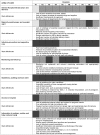Quality of maternal and neonatal care in Albania, Turkmenistan and Kazakhstan: a systematic, standard-based, participatory assessment
- PMID: 22216110
- PMCID: PMC3245221
- DOI: 10.1371/journal.pone.0028763
Quality of maternal and neonatal care in Albania, Turkmenistan and Kazakhstan: a systematic, standard-based, participatory assessment
Abstract
Background: Progress in maternal and neonatal mortality has been slow in many countries despite increasing access to institutional births, suggesting deficiencies in the quality of care. We carried out a systematic assessment of the quality of maternal and newborn care in three CEE/CIS countries, using an innovative approach to identify priority issues and promote action.
Methods: A standard-based tool, covering over 400 items grouped in 13 main areas ranging from support services to case management, was used to assess a sample of ten maternity hospitals in Albania, Kazakhstan and Turkmenistan. Sources of information were visit to services, medical records, observation of cases, and interviews with staff and mothers. A score (range 0 to 3) was attributed to each item and area of care. The assessment was carried out by a multidisciplinary team of international and national professionals. Local managers and staff provided the necessary information and were involved in discussing the findings and the priority actions.
Results: Quality of care was found to be substandard in all 13 areas. The lowest scores (between one and two) were obtained by: management of normal labour, delivery, obstetric complications and sick babies; infection prevention; use of guidelines and audits; monitoring and follow-up. Neonatal care as a whole scored better than obstetric care. Interviewed mothers identified lack of information, insufficient support during labour and lack of companionship as main issues. Actions to improve quality of care were identified at facility as well as at central level and framed according to main health system functions.
Conclusions: Quality of care is a key issue to improve maternal and neonatal outcomes, particularly in countries such as CEE/CIS where access to institutional births is nearly universal. Approaches that involve health professionals and managers in comprehensive, action-oriented assessments of quality of care are promising and should be further supported.
© 2011 Tamburlini et al.
Conflict of interest statement
Figures


References
-
- Van den Broek N, Graham W. Quality of care for maternal and newborn health: the neglected agenda. Brit J Obst Gyn. 2009;116(1):18–21. - PubMed
-
- WHO. Trends in maternal mortality: 1990 to 2008. Estimates developed by WHO, UNICEF, UNFPA and the World Bank. Geneva: World Health Organization;
-
- Rajaratnam JK, Marcus JR, Flaxman AD, Wang H, Levin-Rector A, et al. Neonatal, postneonatal, childhood and under 5 mortality for 187 countries. Lancet. 2010;375:1988–2008. - PubMed
-
- WHO. 2002. Neonatal and Perinatal Country Regional and Global Estimates.
-
- WHO. Health For All Data base. Available: http://www.euro.who.int/en/what-we-do/data-and-evidence/databases/europe...). Accessed 2011 July 18.

